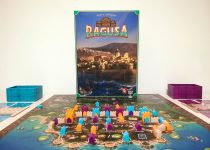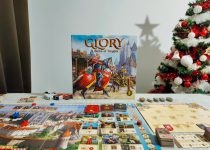Overboss: A Boss Monster Adventure – Journal Entry #26

Overboss: A Boss Monster Adventure quickly became one of my favorite pattern-building games. It is published by Brotherwise Games, the same publishers that gave us Boss Monster. In fact, Overboss is set in the retro-inspired pixel art world of Boss Monster, but it brings an entirely new experience to the table. Kevin Russ, the same guy who designed Calico, my #1 game of 2020, is also one of the designers behind Overboss. That made me dive into Overboss having high expectations, but the game ticked all my boxes!
I grew up playing video games on an old Nintendo console. Titles such as Mario and Street Fighter come to mind. These games hold a special place in my heart and that artwork style will always be one of my favorites. Seeing Overboss all over my Instagram feed reminded me a lot of those times and I was filled with joy when I received the game.
I played Overboss at 2-4 players and it was just as good at all player counts. The only difference at higher player counts is that you can not plan that much in advance. I played it a lot at 2 players, and since you’ve always got 4 pairs of tiles and tokens to choose from, you almost always have a second choice available in case your opponent picks the tile you wanted first. However, at 4 players, chances are the tiles you were looking for are long gone when your turn comes again. However, what put this game on my favorites list is the solo mode.
How to play Overboss: A Boss Monster Adventure
Before going further, I suggest you take a look at my Overboss: A Boss Monster Adventure unboxing article. It will help you get familiar with the components and what each one is used for.
Playing Overboss is pretty simple. To set up the game, you simply pick 5 terrain types and shuffle them together with the dungeon tiles. You must do the same for the monster tokens, the crystals, the portals, and the mini-bosses, which should all be mixed in the bag. Then, decide whether you want to play a longer or a shorter game and use the corresponding side of your player board (3×4 for shorter, 4×4 for longer game). Finish by placing four tiles face-up in the middle of the play area, along with four monster tokens, one for each tile, pulled randomly from the bag.

On a player’s turn, they draft one of the four pair available and place it on their board. The terrain tile can be placed anywhere on your board, but you should pay attention to how that tile is scored, as some spots may earn you more points than others. The monster tokens or mini-bosses must be placed on top of any open terrain tile, except for dungeons. Crystals, portals, and monster tokens that can not be placed on the current tile will be placed in your reserve. You can place these monster tokens as soon as you add a new tile on your board. Portals can be used to swap two monsters or mini-bosses and crystals will award you points depending on how many tiles of that type you have on your board.
As soon as all players filled their boards with terrain tiles, the scoring phase begins. Each terrain type is scored differently. I recommend holding the Quick Start Guide close to you, as it will help you a lot with understanding how scoring works. Monsters are scored in two ways: monsters that match with the terrain tile they are placed on are worth 1 extra point, and monsters that are part of bands also earn you points, based on how many of them are in a band. As in most board games, the player with the most points at the end is the winner!

Once you are familiar with the base rules of Overboss, you can include Boss cards in your game and even Command cards. These spice up the game and bring it to a whole new level. The Boss cards have two abilities: one Reveal ability, a one-time bonus that can be activated when you reveal your Boss card, and one Scoring ability that gives you a new unique way of scoring points.
The Command cards depict a specific pattern and an ability, and are drafted just like the terrain tiles. At the beginning of the game, you place 4 of them face-up in the middle of the play. On your turn, if you managed to replicate the given pattern using terrain tails of a single type on your board, you can activate the corresponding ability. These patterns can be rotated or mirrored, and once you complete them, you will get the ability to move, swap or destroy tiles on any player’s board, even yours. These add more player interaction to the game and can sometimes influence the game a lot!

The solo mode
Overboss comes with two variants for the solo mode: a beat-your-own-score variant, where you play the game as usual and then compare your score to a table to see how well you did, and a campaign mode.
As I’ve mentioned earlier, the solo mode is what put Overboss on my favorites list. The campaign mode felt unique to me (I never encountered this variant of solo mode before) and felt like it really fits the theme. You will face 6 levels that will tell you which tiles and bosses to use and you’ll be given 3 objectives for each level. In order to pass to the next level, you have to complete at least two of these objectives, otherwise you’ll have to repeat the level. These objectives award you Soul Gems, and completing all three objectives on a level will award you a Villainy icon. The Soul Gems and the Villainy icons will increase your final score after you finish the campaign.

What makes it even more interesting is that you can choose the difficulty you want and you’ll have a certain number of lives available to reach the final level and beat it. Each time you fail to finish a level (by completing at least two objectives), you lose one life. You also have some side quests available that will award you even more Soul Gems.
My thoughts on Overboss: A Boss Monster Adventure
If you didn’t get the idea yet, I will state it clearly: I love Overboss and it is currently in my top 5 games of 2021. The rules are easy to learn, it plays fast and the artwork is delightful! It plays at about 10 minutes per player and it is so fun that we played it for 4 hours straight when I first got it.
The game is accesible to all kind of gamers. The base rules are good enough to play it with people that are new to the hobby and make sure that they’ll enjoy it. I think heavy gamers will also enjoy it, especially if you add the Boss cards and the Command cards in play. They add enough choices to deepen the strategy involved in playing it. There’s also a lot of variety in this game, as you only use 5 terrain types out of the 10 available (+ the Dungeons), so matches will differ a lot based on what tiles you are using. Even changing one or two terrain tiles from the pool will change the experience by a lot and require a different strategy.

The game can be actually split into two grids that you must take care of: the terrain and the monsters. You should always pay attention to both grids and plan your pick accordingly. Do not ignore one or the other as you’ll lose a lot of potential points! I noticed that people often ignore the monster and focus more on scoring terrain tiles. However, you should keep in mind that forming bands can score you up to 7 points per row/column and matching monsters to their terrain tiles also awards you extra points, This may not sounds like a lot, but sometimes this can make the difference between the winner and the ones who lose.
The Command cards add a new level to the pattern-building aspect of this game. Sure, there’s pattern building involved in the way some tiles score too, but these cards require actual patterns to be built in order to be activated. However, I noticed that they get harder and harder to use the more players there are. At 2 players, building the required patterns using a single terrain type is pretty easy, as your get to pick a tile every two turns.
However, at 3 and 4 players, the distance between your turns increases and tiles are getting drafted more, so other players may pick the tiles you need before you get your chance to do so. I even had matches when no one was able to use a Command card because of this. However, I still enjoy the player interaction that they add to the game. You can really mess up someone’s board if you get to use some of these cards!

The campaign mode feels very thematic to me. Overboss is inspired from video games and this mode really seems like a good implementation of a video game in a board game format. I got addicted to it very fast and it took me many tries to finish the campaign for the first time. Having variable terrain tiles and bosses available on each level is very challenging, especially as the objectives get more difficult as you advance through the levels.
Conclusion
Overboss: A Boss Monster Adventure is one of my favorite games of 2021, along with Chronicles of Crime: 1900 and Venice. It is very fun to play and the variety given by the terrain tiles makes it highly replayable and can become addictive if you enjoy the theme and the way it is implemented. The artwork is very appealing and helps the game a lot. Having to plan your picks based on two grids adds enough strategy to the game to make it great for both newbies and more seasoned gamers. Recommended if you like pattern-building games like Calico, Azul, or Sagrada!
Useful info
Designers: Aaron Mesburne & Kevin Russ
Publisher: Brotherwise Games
Players: 1-5
Time: 20-30 min
Times played: 14
Full disclosure: A copy of Overboss: A Boss Monster Adventure was provided by the game publisher.
Did you like the review? Follow me on my Instagram page where I post daily photos of games I play and other things. You can also support me on Patreon to gain access to various special content, such as game unboxings, first impressions, polls to decide what games to cover next, and early access to reviews!



Played it a couple weeks ago with a friend of mine. Now that I’ve read about the solo mode here, I’m really curious to try that too. I’ll have to see if I can find it in any shops. Thanks!